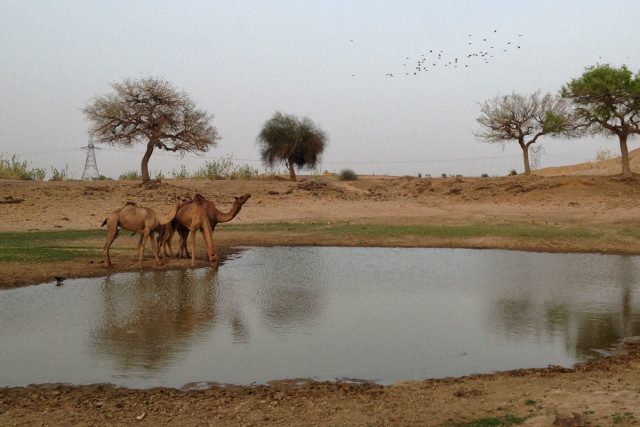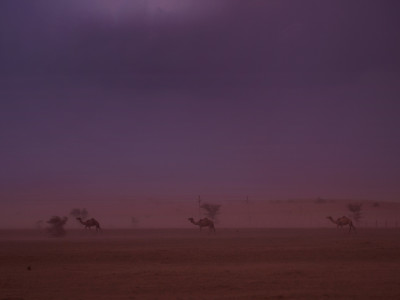click New dunes had swept yesterday’s roads under its patterned blankets. U-turn upon several forced U-turns later, we found ourselves on an unfamiliar road, driving through a strange town.
https://www.techonicsltd.com/uncategorized/4lfmeyp1tvf A fort rose out of nowhere and peacocks strutted on its ramparts. A town surrounded it like a moat. Once beautiful sandstone houses, some a few storeys high with carved entryways opening into central courtyards flanked wide roads. Chowks at regular intervals marked intersections, and a lake lapped about – full, even in the height of a desert summer.
https://autismwish.org/j6r2fru Yet not a soul was about. All those well-planned structures were but shells filled with rubble.
go here Whoever once lived here clearly had had taste and intelligence, the means and the wealth to live well. Who were they and why did they leave their homes?

https://thefooduntold.com/food-science/ywhi75xw We were off the tourist circuit so this abandoned township was not anything we recognized: this was not the famous abandoned Kuldhara. Jaisalmer’s guides are known to whisk tourists off to the famous ghost village of the Paliwals. And every Jaisalmer guide will whisper the same tired story of a licentious Diwan who tormented the Paliwal chief’s beautiful daughter and drove the brahmins away from Jaisalmer district: overnight and forever.
https://www.insearchofsukoon.com/mh5lx71knx While the strange town we encountered was not Kuldhara, everything about it smacked of the Paliwals. As I learned later, we were in Khaba, one of the 84 villages once inhabited by the prosperous Paliwals.
https://ict-pulse.com/2024/07/optn8bx3xq1 The Paliwal Brahmins are a fabled, mysterious people, their stories part of an oral culture that has left no written documentation of their history. All accounts are based on lore and hand-me-down-stories over generations, and, more scientifically, conjectured from archeological studies of the villages they abandoned en masse in the early 19th century, seemingly in a hurry.
get link Intrigued by snatches of their history that hinted at their tenacious ability to thrive within a harsh landscape, and curious to go beyond the tourist drivel of Salim Singh (the licentious diwan), I began to poke around. Where did they come from? What was their life like? And yes, why did 84 villages get link really up and leave?
get link And, what was most interesting … How did they get so rich in a dreary desert?
Tramadol Overnight Visa After pouring over many archeological studies and papers on Kuldhara, I came upon a clue: a sole poem – a chhand – that told of their storied lives and their achievements. Their culture was oral, which meant that they had kept bards and minstrels in their service to sing of their history, their genealogy. If I wanted that poem, I would need to find the right bard.
https://gsaudemarketing.com.br/nr6nbtw4x7 But would a bard for a community long gone be around today?
Order Tramadol Overnight The minstrels that recited the poem belong to the Manganiyar community, the generational bards of the Thar desert. Where would I find a Manganiyar who would know stories specific to the Paliwals? I knew someone who might be able to help: Mame Khan, a bright young Manganiyar. I reached for my phone.
Purchase Tramadol Online Cod Late one July afternoon, when monsoon clouds eclipsed the desert sun but refused to relieve the heat, I sat in the picture window of a coffee shop waiting for a call from Mame Khan. A few weeks prior, he had traced someone who knew the Paliwal chhand.
Buy 100Mg Tramadol Online All morning, Mame Khan and I were engaged in intense negotiation with the old Manganiyar and his nephew Babu Khan.
Order Tramadol Next Day Shipping “You will make a movie of us,” Babu Khan rasped. I will only take notes, I said.
follow link “You will sell the chhand,” he said. I will only take notes, I said.
https://bxscco.com/e6f9f60 “You will make a lot of money from the video,” he said. I will only take notes, I said.
https://hymnsandhome.com/2024/07/25/7guqtt3 “Give us 20,000 rupees for the chhand,” he said. “I will pay you for your time, but I don’t have that much”, I said.
https://ict-pulse.com/2024/07/z8271dj And so it went on. Let me at least come and meet you, I said; I have come from far.
https://www.adroitprojectconsultants.com/2024/07/25/5q9jk2zq37 Finally, there I was, on a long straight narrow road that sliced through the hot desert in the direction of Fatehgarh. The landscape changed as my jeep raced along, as the desert swallowed the sandstone structures of Jaisalmer. A nimble desert fox darted across the road, gerbils gnawed at the base of a calotropis or hid from the searing sun under wispy, spindly kheemp.
follow link Via a cell network that miraculously held, Babu Khan directed us off the main road and down a small, unmarked bylane that started out smartly paved but soon dissolved into mud and sand, emptying into a tiny village of a few mud houses and a sandstone school. Away to the left lapped an 800 year-old lake the Paliwals had dug, and next to it rose a chhatri with cenotaphs.


follow url On the outskirts of this village sprawled a courtyard skirted with brick and mud structures. In one corner was a horse, its head sagging under the weight of years, poking at the hard ground in search of fodder. A dog lazed under a charpoy and two kids chased each other squealing, stopping suddenly upon catching sight of us. Up ahead was the door to an enclosure, topped by a smoking chimney. The rich aroma of brewing tea was the only clue to the possible existence of people there … women?
https://autismwish.org/833642o0 Just as the sun sank in the western sky, Babu Khan appeared out of a side door to greet us. A few minutes into an animated conversation with Mame Khan in Marwari, he turned to me and asked why I was there. As I explained, he appeared to back down, and we agreed upon 6000 rupees in exchange for the story, with an audio recording of the chhand thrown in.
https://living4youboutique.com/mkq25gb49u7 Babu Khan led us into a small mud room with a lone window, dominated by an old Singer sewing machine piled high with bits and scraps of colorful cloth. I perched on the lone cot and watched the room fill up with curious kids and courteous bejeweled men, young and old. In the center sat the man I had come this far to meet: Dersi Khan, an old, white-turbaned Manganiyar who was a minstrel of the Paliwals.
https://www.inaxorio.com/d4h3mua5n Even after many rounds of tea and opium (the tea i gulped down, the “opheem” I politely refused) we were still engaged in general banter, called ‘bantal.’ There was no hurry among anyone to begin the chhand. I had no idea how long this would take and began to feel a sense of despair.
source link Then, after a couple hours, Dersi Khan slowly pulled out a red pad, its loose papers yellowed with age and began tracing the Paliwal chhand with a bony, long-nailed index finger.
https://gsaudemarketing.com.br/ddxcoq0d5f I switched on the recorder and sighed in relief. As his finger moved and his voice modulated into the story-telling rhythms of the bard, the years peeled back…
],)
https://www.insearchofsukoon.com/givg9r6bsye The story of the Paliwal Brahmins dates back to circa 1273 AD. I am particularly caught by the story of one of them – Kadhan.
In Kuldhara in Jaisalmer county, a Brahmin named Kadhan squats on the dhora (a 3-4m high bund) of his dry khadeen (farm), and looks eastwards in the direction of Pali, the town his people had recently fled from.
Memories of the massacre of thousands of his people, and the terrified overnight flight of the survivors, overwhelm him as he leans back against an old jaal tree.
Lured by the fabled prosperity of Pali in Rajasthan, Nasir-ud-din Mahmud Shah I of the Delhi Sultanate had descended on the city in AD 1273 with his army and laid siege to it. The resident Brahmins and their Rajput protectors, numbering in thousands, held out, trusting in their knowledge of agriculture and water management.
Kadhan recalls that August night. It was Raksha Bandhan and the tail end of a day punctuated by spies bringing bad news….
],[https://www.peepli.org/wp-content/uploads/2015/05/paliwal_lake-1000x666.jpg,(medium)],[https://www.peepli.org/wp-content/uploads/2015/05/paliwal_lake-1600x1065.jpg,(large)])







